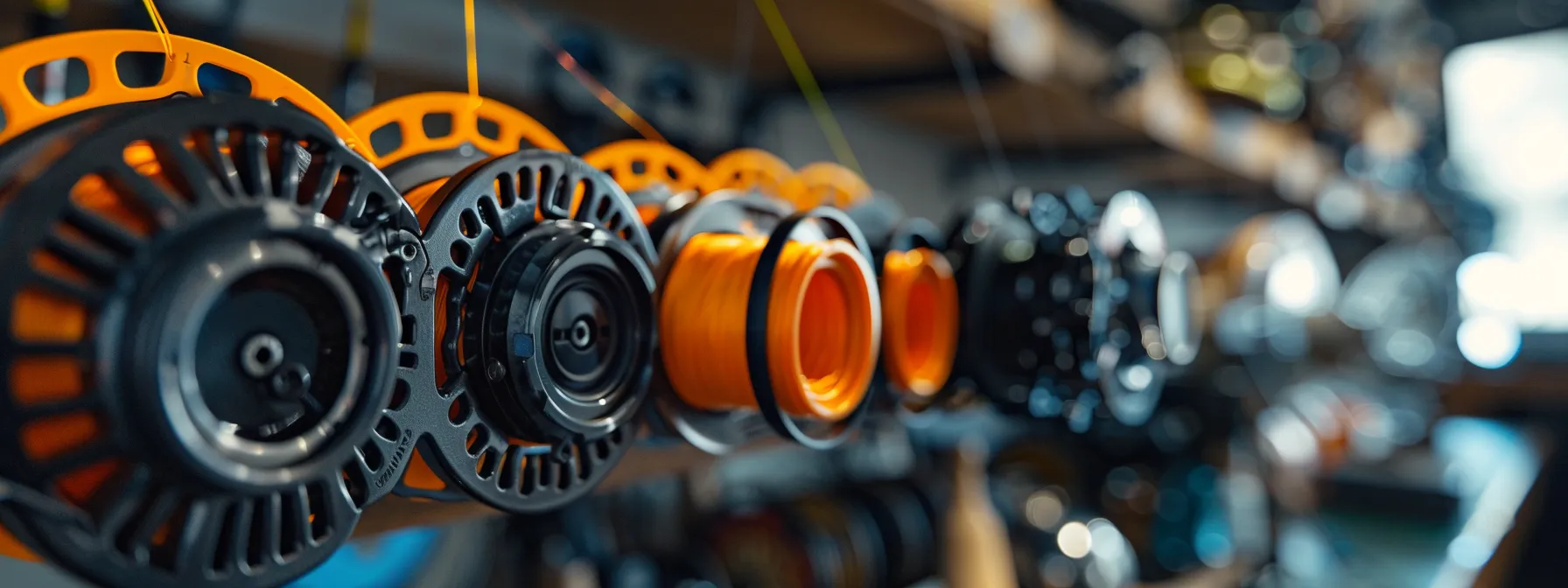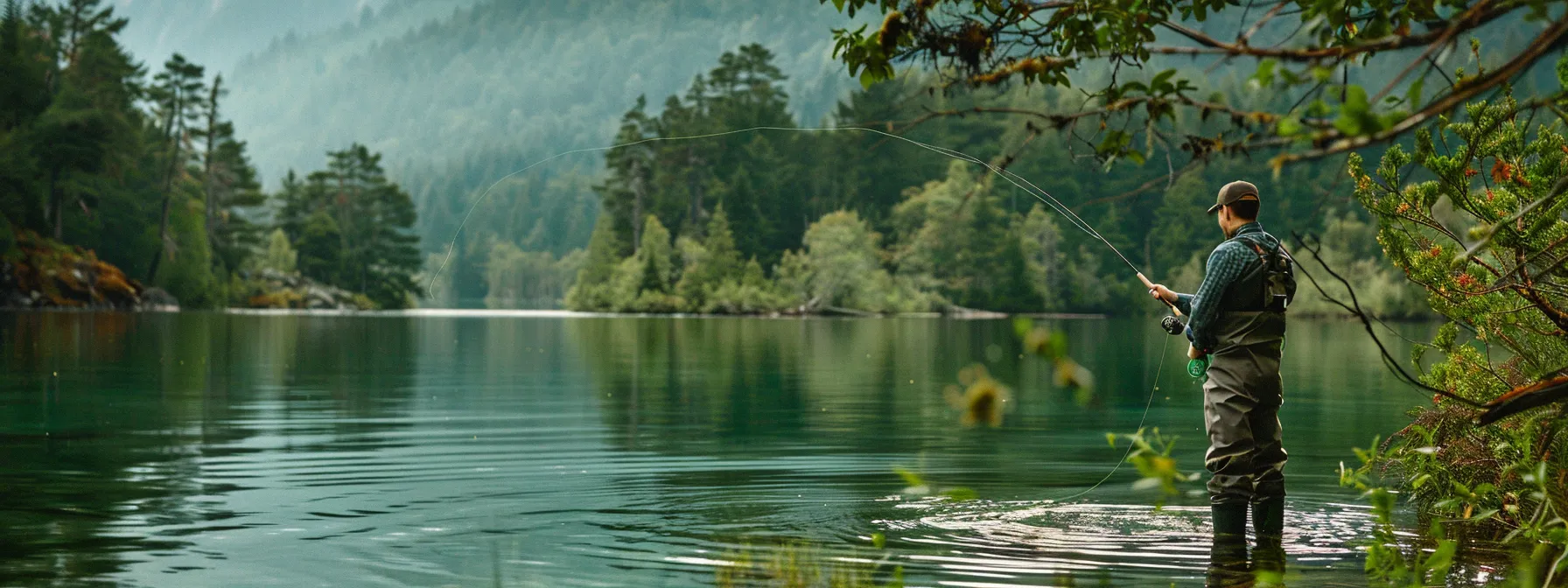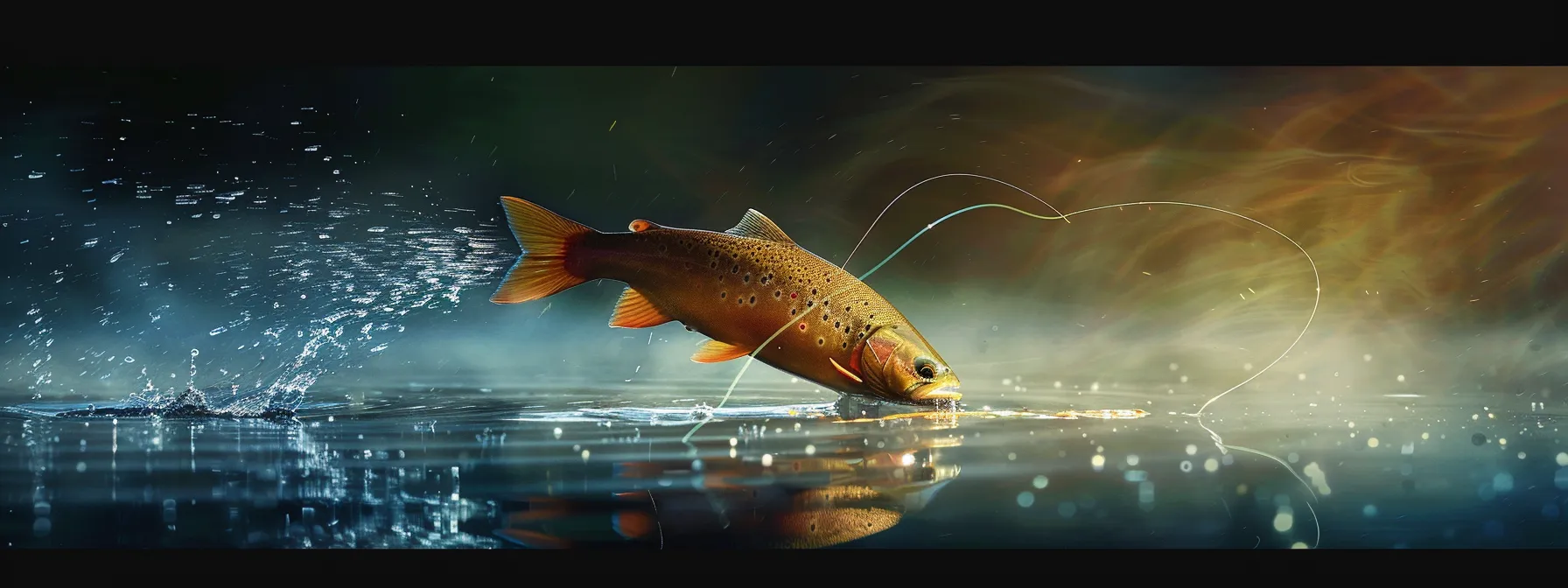Are you struggling to catch more brown trout or bass while fly fishing? Understanding the differences between floating and sinking fly lines can significantly impact your success. In this post, I’ll break down the advantages of each type, how to choose the right line for your environment, and tips for mastering casting techniques. By the end, you’ll know how to effectively navigate the water column, considering factors like density and diameter, to enhance your fishing experience and increase your catch rate. Let’s dive in and optimize your fly fishing techniques!
Understanding the Basics of Fly Lines

Understanding the basics of fly lines is essential for optimizing your fishing techniques. I’ll cover how to differentiate between floating and sinking lines, the impact of line density on casting, and the importance of selecting the appropriate line weight. Additionally, I’ll discuss All Products how to match lines with rods and reels to enhance your overall fishing tackle experience.
Differentiating Floating and Sinking Lines
When it comes to fly lines, understanding the difference between floating All Products and sinking lines is crucial for targeting species like rainbow trout. Floating lines are designed to stay on the surface, making them ideal for dry fly fishing and situations where you want your flies to mimic insects on the water. On the other hand, sinking lines are essential for reaching deeper waters, allowing you to present your flies at the right depth to entice trout that are feeding below the surface. Choosing the right line based on buoyancy can significantly enhance your gear's effectiveness and improve your fly tying strategies Gutenberg eBook Images.
Impact of Line Density on Casting
The density of your fly line plays a significant role in casting and overall fly fishing success. As a caster, understanding how line density affects your tippet and fly presentation can make a big difference. For instance, a heavier sinking line allows you to reach deeper waters quickly, which is essential when targeting fish that are feeding below the surface. Conversely, a floating line provides better control for dry flies, allowing you to mimic natural insect behavior effectively. By selecting the right line density, you can enhance your casting accuracy and improve your chances of a successful catch.
Selecting the Appropriate Line Weight
Selecting the appropriate line weight is crucial for any fisherman looking to optimize their fly fishing techniques. A well-matched fly line weight ensures that your setup performs effectively, whether you're targeting tarpon in saltwater or trout in freshwater. For instance, if you're using a heavier fly line, it can help you cast larger flies and reach deeper waters, while a lighter line weight allows for more delicate presentations, making it easier to mimic natural insect behavior. Understanding this balance will enhance your overall fishing experience and increase your chances of a successful catch.
Matching Lines With Rods and Reels
Matching your fly lines with the right rods and reels is essential for maximizing your fishing success, especially when targeting species like striped bass in lakes. A well-balanced setup allows for a smooth casting stroke, ensuring that your line performs optimally whether you're engaging in dry fly fishing or using sinking lines. For example, if I’m using a heavier sinking line, I pair it with a rod that has the appropriate action to handle the weight, which enhances my ability to present flies effectively at the desired depth.
- Understand the difference between floating and sinking lines.
- Consider the species you are targeting, such as striped bass.
- Match line weight with rod action for optimal performance.
- Ensure your reel can handle the line's weight and type.
- Practice your casting stroke to improve accuracy and distance.
Now that we’ve covered the basics of fly lines, it’s time to explore the benefits of floating fly lines. These lines can change your fishing game, making every cast count.
The Advantages of Floating Fly Lines

Floating fly lines excel in specific conditions, making them a go-to choice for many anglers. I’ll discuss optimal scenarios for using floating lines, techniques to enhance their performance, and common challenges you might face along with practical solutions. Additionally, I’ll share maintenance tips to ensure your floating lines last, complementing your Fishing Tools Collection and Nets Collection for a successful outing.
Optimal Conditions for Floating Lines
Floating fly lines are particularly effective in calm waters, where the surface is undisturbed, allowing for precise presentations of dry flies. I find that early morning or late evening, when insects are most active, are optimal times to use floating lines. Additionally, fishing in shallow streams or ponds where fish are feeding on the surface can lead to successful catches, as the floating line keeps your flies at the perfect level to attract attention:
- Calm waters enhance the effectiveness of floating lines.
- Early morning and late evening are prime times for surface activity.
- Shallow streams and ponds are ideal for targeting surface-feeding fish.
Techniques to Improve Performance With Floating Lines
To enhance the performance of floating fly lines, I recommend focusing on your casting technique and presentation. A smooth, controlled cast allows the line to land gently on the water, minimizing disturbance and increasing the chances of attracting fish. Additionally, using a technique called "mending" can help adjust the line's position on the water's surface, allowing for a more natural drift of your fly, which is crucial when targeting surface-feeding fish.
Common Challenges and Solutions
One common challenge I encounter with floating fly lines is dealing with wind, which can create unwanted drag and affect my presentation. To combat this, I focus on adjusting my casting angle and using a longer leader to help maintain a natural drift. Additionally, I pay attention to the line's tension and make necessary adjustments to ensure my flies remain enticing to surface-feeding fish.
Maintenance Tips for Longevity
To ensure the longevity of your floating fly lines, I recommend a few key maintenance practices. After each fishing trip, rinse your line with fresh water to remove any dirt, salt, or debris that could degrade its performance. Additionally, regularly inspect your line for any nicks or abrasions, as these can affect casting and presentation. Proper storage is also essential; I always keep my lines on a spool in a cool, dry place to prevent memory and tangling. By following these simple steps, you can extend the life of your floating lines and maintain their effectiveness on the water:
- Rinse your line with fresh water after each use.
- Inspect for nicks or abrasions regularly.
- Store lines on a spool in a cool, dry place.
Floating lines have their place, but sometimes the fish lie deeper. Let’s explore the benefits of sinking fly lines and how they can change your catch.
Benefits of Using Sinking Fly Lines

Sinking fly lines are essential for reaching fish that are feeding below the surface. I’ll discuss situations ideal for using sinking lines, explore different sink rates to match your fishing conditions, and share handling techniques that enhance your effectiveness. Additionally, I’ll cover how to combine sinking lines with various flies to maximize your chances of a successful catch.
Situations Ideal for Sinking Lines
Sinking fly lines are particularly effective in situations where fish are feeding below the surface, such as in deeper lakes or rivers with varying depths. I often find that targeting species like bass or trout in these environments requires a sinking line to present my flies at the right depth. Additionally, when fishing in fast-moving water, a sinking line helps me maintain control and keep my flies in the strike zone longer, increasing my chances of a successful catch:
- Ideal for deeper lakes and rivers.
- Effective for targeting species like bass and trout.
- Helps maintain control in fast-moving water.
Exploring Different Sink Rates
When it comes to sinking fly lines, understanding different sink rates is vital for effectively targeting fish at various depths. I often choose between slow, medium, and fast sink rates based on the conditions and the species I'm pursuing. For example, a slow sink line is perfect for presenting flies to fish that are just below the surface, while a fast sink line allows me to reach deeper waters quickly, especially in lakes where fish are holding at greater depths:
- Slow sink lines are ideal for shallow waters and surface feeders.
- Medium sink lines work well in varying depths, providing versatility.
- Fast sink lines are essential for deep lakes and fast-moving rivers.
Handling Techniques for Sinking Lines
When using sinking fly lines, mastering handling techniques is key to improving your catch rate. I focus on maintaining a steady retrieve, which helps keep my flies in the strike zone longer, especially when targeting fish that are feeding below the surface. Additionally, I often vary my retrieve speed and incorporate pauses to mimic the natural movement of prey, making my presentation more enticing to species like bass and trout.
Combining Sinking Lines With Various Flies
Combining sinking lines with various flies is a game-changer for targeting fish that are feeding below the surface. I often use streamers or nymphs with sinking lines to effectively reach the depths where species like trout and bass are lurking. By matching the sink rate of the line with the action of the fly, I can create a more enticing presentation that mimics natural prey, increasing my chances of a successful catch.
Sinking fly lines open up new depths, but the right line makes all the difference. Let’s explore how to choose the perfect fly line for your fishing environment.
Choosing the Right Fly Line for Your Environment

Choosing the right fly line for your environment involves assessing water conditions and depths, understanding target fish species behavior, and adapting to seasonal changes. I’ll also explore how environmental factors can influence your line choice. Each of these elements plays a crucial role in optimizing your fly fishing techniques, ensuring you have the best chance for a successful catch.
Assessing Water Conditions and Depths
Assessing water conditions and depths is vital for selecting the right fly line, whether I’m fishing in a calm pond or a fast-moving river. I pay close attention to factors like water clarity, temperature, and current speed, as these elements influence fish behavior and feeding patterns. For instance, in deeper waters where fish tend to hold, I opt for sinking lines to effectively reach the desired depth, while in shallower areas, a floating line allows me to present my flies right where the fish are actively feeding.
Considering Target Fish Species Behavior
Understanding the behavior of target fish species is essential when choosing the right fly line for your environment. For instance, if I'm targeting fish that are actively feeding near the surface, like trout during a hatch, I opt for a floating line to keep my flies in the strike zone. Conversely, when fishing for species that prefer deeper waters, such as bass or pike, I select a sinking line to effectively reach the depths where these fish are lurking:
- Identify the feeding habits of your target species.
- Choose a floating line for surface feeders.
- Opt for a sinking line when targeting fish at greater depths.
Adapting to Seasonal Changes
Adapting to seasonal changes is crucial for optimizing my fly fishing techniques, especially when deciding between floating and sinking fly lines. In spring, as water temperatures rise, I often find fish moving closer to the surface, making floating lines more effective for targeting active feeders. Conversely, during the heat of summer or in colder months, I switch to sinking lines to reach fish that retreat to deeper, cooler waters, ensuring I present my flies at the right depth for a successful catch.
Environmental Factors Affecting Line Choice
Environmental factors play a significant role in determining the right fly line for your fishing conditions. For instance, I always consider water temperature and clarity, as these elements can influence fish behavior and feeding patterns. In warmer waters, fish may be more active near the surface, making floating lines a better choice, while in colder or murkier conditions, sinking lines can help me reach fish that are holding deeper, ensuring I present my flies where they are most likely to bite.
With the right fly line in hand, you’re ready to take on the water. Next, let’s dive into the art of casting, where floating lines become your best ally in the pursuit of the perfect catch.
Mastering Casting Techniques With Floating Lines

To master casting techniques with floating lines, I focus on enhancing accuracy and distance, which are crucial for effective presentations. I also tackle challenges like wind and obstacles that can disrupt my cast. By implementing advanced casting methods and practicing specific drills, I continuously improve my skills, ensuring I can present my flies precisely where the fish are feeding.
Enhancing Accuracy and Distance
To enhance accuracy and distance when casting with floating lines, I focus on my technique and body positioning. A smooth, controlled cast is essential; I ensure my rod tip follows a straight path, which helps the line land softly on the water. Practicing specific drills, such as double-hauling, allows me to generate more line speed and distance, making it easier to reach those elusive fish that are feeding on the surface:
- Focus on smooth, controlled casting techniques.
- Maintain proper body positioning for better accuracy.
- Practice double-hauling to increase line speed and distance.
Overcoming Wind and Obstacles
When faced with wind and obstacles while casting with floating lines, I focus on adjusting my technique to maintain accuracy. I often lower my casting angle to keep the line closer to the water, which helps reduce wind interference. Additionally, I practice casting in open areas to build confidence and refine my skills, allowing me to tackle challenging conditions more effectively when I’m out on the water.
Implementing Advanced Casting Methods
Implementing advanced casting methods, such as the double haul, has significantly improved my accuracy and distance when using floating lines. This technique involves pulling on the line with my non-dominant hand during the backcast and forward cast, which generates extra line speed and allows me to reach fish that are further away. By practicing this method regularly, I’ve been able to present my flies more effectively, even in challenging conditions, ensuring I can target surface-feeding fish with precision.
Practice Drills for Skill Improvement
To improve my casting skills with floating lines, I focus on specific practice drills that enhance both accuracy and distance. One effective drill involves setting up targets at varying distances and practicing my cast to hit each one consistently. This not only sharpens my precision but also helps me gauge how different line weights and rod actions affect my performance. By dedicating time to these drills, I can refine my technique and ensure that I’m ready to present my flies exactly where the fish are feeding.
Floating lines help you master the surface, but the depths hold their own secrets. Sinking fly lines can take your casting to new places, where the fish lie waiting.
Optimizing Casts With Sinking Fly Lines

Managing sink rates is crucial for effective casting with sinking fly lines. I’ll share strategies for deep water fishing, ensuring you can reach the right depths where fish are feeding. Additionally, I’ll discuss how to adjust your techniques for different currents and provide tips for smooth retrievals, enhancing your overall fishing success.
Managing Sink Rates for Effective Casting
Managing sink rates is essential for effective casting with sinking fly lines, especially when targeting fish at various depths. I often adjust my retrieve speed based on the sink rate of my line to ensure my flies stay in the strike zone longer. For instance, when using a fast sink line, I maintain a steady retrieve to keep my flies near the bottom, where species like bass are often lurking, while a slower sink line allows for a more leisurely presentation that can entice fish just below the surface.
Strategies for Deep Water Fishing
When fishing in deep waters, I focus on using a steady retrieve to keep my flies in the strike zone longer. This approach is crucial for enticing fish that are often lurking near the bottom. I also pay attention to the sink rate of my line; for instance, when using a fast sink line, I maintain a consistent speed to ensure my flies stay close to the depths where species like bass are found. By adjusting my retrieve based on the conditions, I can effectively present my flies and increase my chances of a successful catch.
Adjusting Techniques for Different Currents
When fishing in different currents, I adjust my techniques to ensure my sinking fly lines perform effectively. In fast-moving water, I focus on a quicker retrieve to keep my flies in the strike zone, allowing them to mimic the natural movement of prey. Conversely, in slower currents, I slow down my retrieve, giving fish more time to react and increasing my chances of a successful catch:
- Adjust retrieve speed based on current flow.
- Use a quicker retrieve in fast-moving water.
- Slow down in slower currents for better fish response.
Tips for Smooth Retrievals
For smooth retrievals with sinking fly lines, I focus on maintaining a steady and consistent speed throughout the retrieve. This approach helps keep my flies in the strike zone longer, increasing the chances of enticing fish. I also pay attention to the tension in the line; if I feel a sudden change, I adjust my retrieve speed accordingly to ensure my presentation remains natural and appealing to the fish:
- Maintain a steady and consistent retrieve speed.
- Keep flies in the strike zone longer for better chances of a catch.
- Adjust retrieve speed based on line tension and fish response.
Conclusion
Optimizing your fly fishing techniques by understanding the differences between floating and sinking fly lines is essential for success on the water. Selecting the right line based on your target species and fishing conditions enhances your ability to present flies effectively, whether you're targeting surface feeders or fish lurking below. Mastering casting techniques and managing sink rates further improve your chances of a successful catch. By applying these insights, you can elevate your fishing experience and consistently achieve better results.


